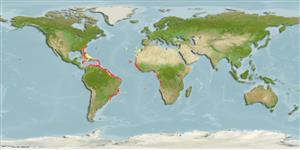Common names from other countries
Environment: milieu / climate zone / depth range / distribution range
экология
донно-пелагический; солоноватоводный; пределы глубины 1 - 421 m (Ref. 105052). Tropical; 35°N - 31°S, 82°W - 14°E
Atlantic Ocean: from southeastern Florida to Brazil rarely in Bermuda and North Carolina, also in the Cape Verde Islands and along the African coast from Mauritania to Angola.
Length at first maturity / Size / Вес / Возраст
Maturity: Lm ? range ? - ? cm Max length : 10.0 cm CW самец/пол неопределен; (Ref. 417)
In shallow littoral environments, typically from intertidal pools to 3 m (Ref. 105199). Inhabits shallow salt water on sandy or sandy mud bottom (Ref. 435) in brackish waters of estuaries (Ref. 417). Also found on algae and grass flats, sandy beaches, rocky pools, eroded coral bases (Ref. 105199), coral reef (Ref. 121879), oyster bars (Ref. 105199), and edge of mangroves (Refs. 105199, 121880). Rarely found in the open sea, from the intertidal to depth of 25 m (Ref. 121880). Associated with the barnacle Chelonibia sp. (Ref. 105200). In general, portunids are opportunistic omnivores with preference for animal prey (Ref. 100840).
Life cycle and mating behavior
половая зрелость | размножение | нерест | икра | Fecundity | личинки
Members of the order Decapoda are mostly gonochoric. Mating behavior: Precopulatory courtship ritual is common (through olfactory and tactile cues); usually indirect sperm transfer.
Основная ссылка
ссылки | координатор | соавторы
Fischer, W., G. Bianchi and W.B. Scott (eds.). 1981. (Ref. 435)
Статус Красного Списка МСОП (Ref. 130435)
Статус СИТЕС (Ref. 108899)
Not Evaluated
Not Evaluated
Использование человеком
рыболовство: коммерческий
| FishSource |
инструменты
дополнительная информация
ресурсы в Интернет
Estimates based on models
Preferred temperature
(Ref.
115969): 14.1 - 24.4, mean 17.5 (based on 89 cells).
Уязвимость
Low vulnerability (10 of 100).
